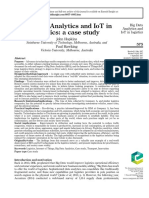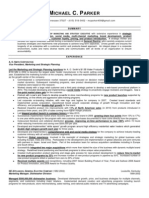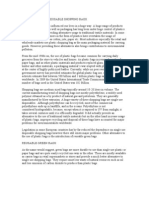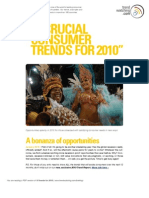McKinsey Big Data
McKinsey Big Data
Uploaded by
akshatmalhotraCopyright:
Available Formats
McKinsey Big Data
McKinsey Big Data
Uploaded by
akshatmalhotraCopyright
Available Formats
Share this document
Did you find this document useful?
Is this content inappropriate?
Copyright:
Available Formats
McKinsey Big Data
McKinsey Big Data
Uploaded by
akshatmalhotraCopyright:
Available Formats
1
M AY 2 0 11
m c k i n s e y
g l o b a l
i n s t i t u t e
The challengeand opportunity of big data
A new report explores the explosive growth of digital information and its potential uses.
The proliferation of data has always been part of the impact of information and communications technology. Now, as computers and cell phones continue to pervade our daily activities and as millions of networked sensors are being embedded in these devices (as well as in automobiles, smart meters, and other machines), the amount of data available for analysis is exploding. The scale and scope of the changes that such big data are bringing about have reached an inflection point. Companies capture trillions of bytes of information about customers, suppliers, and operations. Many citizens look with suspicion at the amount of data collected on every aspect of their lives. Can big data play a useful role? New research from the McKinsey Global Institute (MGI) finds that collecting, storing, and mining big data for insights can create significant value for the world economy, enhancing the productivity and competitiveness of companies and the public sector and creating a substantial economic surplus for consumers. The report Big data: The next frontier for innovation, competition, and productivity explores the state of digital data, how different domains can use large data sets to create value, and the implications for the leaders of private-sector companies and public-sector organizations, as well as for policy makers. The reports analysis is supplemented by a detailed examination of five domainshealth care, retailing, the public sector, manufacturing, and personal-location data. MGIs analysis shows that companies and policy makers must tackle significant hurdles to fully capture big datas potential. The United States alone faces a shortage of 140,000 to 190,000 people with analytical and managerial expertise and 1.5 million managers and analysts with the skills to understand and make decisions based on the study of big data (exhibit). Companies and policy makers must also tackle misaligned incentives around issues such as privacy and security, access to data, and technology deployment. The report identified five broadly applicable ways to leverage big data: 1. Make big data more accessible and timely. Transparency, enabled by big data, can unlock a great deal of value. In the public sector, increasing access to data across separate departments can sharply reduce search and processing times. In manufacturing, integrating data from R&D, engineering, and manufacturing units to facilitate concurrent engineering can cut time to market. 2. Use data and experiments to expose variability and raise performance. As organizations create and store more transactional data in digital form, they can collect more accurate and detailed performance information on everything from product inventories to sick days. 3. Segment populations to customize. Big data allow organizations to create ever-narrowing segmentations and to tailor services precisely to meet customer needs. This approach is well known in marketing and risk management but can be revolutionary in areas such as the public sector.
Web 2011 Big data teaser Exhibit 1 of 1
Exhibit
Demand in the United States for people with deep expertise in data analysis could be greater than its projected supply in 2018.
Deep analytical talent, thousands of FTEs1 Supply 2008 employment Forecast of graduates Net of additions through immigration and reemployment of previously unemployed minus expected attrition Projected 2018 supply 2018 demand to realize full potential of big data 156 +161 32 285 425475 5060% gap relative to supply given current trends, equal to 140,000190,000 unlled positions
1 Deep
analytical talent are people who have advanced training with statistics or machine learning. FTE = full-time equivalent. Source: Dun & Bradstreet; company interviews; US Bureau of Labor Statistics; US Census Bureau; McKinsey Global Institute analysis
Related thinking Clouds, big data, and smart assets: Ten techenabled business trends to watch The Internet of Things The global grid Meeting the demand for data storage
4. Use automated algorithms to replace and support human decision making. Sophisticated analytics can substantially improve decision making, minimize risks, and unearth valuable insights that would otherwise remain hidden. Such analytics have applications from tax agencies to retailers. 5. Innovate with new business models, products, and services. To improve the development of next-generation offerings and to create innovative after-sales services, manufacturers are leveraging data obtained from the use of products. The emergence of real-time location data has created a new set of location-based mobile services from navigation to people tracking. Read the executive summary or download the full report on the McKinsey & Company Web site.
Copyright 2011 McKinsey & Company. All rights reserved.
You might also like
- Digital Twin Technology in Operations ManagementDocument25 pagesDigital Twin Technology in Operations Managementnishantha.senaratneNo ratings yet
- 2014 Fact Book LRDocument40 pages2014 Fact Book LRYul Armand OrtigasNo ratings yet
- Handbook of Big Data Technologies: Albert Y. Zomaya, Sherif Sakr (Eds.)Document1 pageHandbook of Big Data Technologies: Albert Y. Zomaya, Sherif Sakr (Eds.)essarNo ratings yet
- IbmDocument6 pagesIbmhoangminh87No ratings yet
- An Application of The Analytic Network Process in Multiple Criteria Material SelectionDocument11 pagesAn Application of The Analytic Network Process in Multiple Criteria Material SelectionM. Nishom, S.KomNo ratings yet
- MemoQ Server Installation GuideDocument18 pagesMemoQ Server Installation GuideLeon0% (1)
- 03-DataTransmission Rev1.6 SDocument37 pages03-DataTransmission Rev1.6 SSoldier 98No ratings yet
- Ball Mill Shell Vibration Signal Analysis Strategy Based On DEM-FEMDocument5 pagesBall Mill Shell Vibration Signal Analysis Strategy Based On DEM-FEMKIMANINo ratings yet
- Water and Wastewater 12 2014 01 2015Document49 pagesWater and Wastewater 12 2014 01 2015Tiffany JohnsonNo ratings yet
- MVR Retrofit Commercialisation StudyDocument82 pagesMVR Retrofit Commercialisation StudysreenuNo ratings yet
- Crash Course On Data Stream Algorithms: Part I: Basic Definitions and Numerical StreamsDocument76 pagesCrash Course On Data Stream Algorithms: Part I: Basic Definitions and Numerical Streamsumayrh@gmail.comNo ratings yet
- Memo Perkins Industrial Cabinet CoDocument2 pagesMemo Perkins Industrial Cabinet CoEeshan BhagwatNo ratings yet
- An Overview of Current Gaps and Research NeedsDocument271 pagesAn Overview of Current Gaps and Research NeedsABakendiNo ratings yet
- Internet of Things-Enabled Smart Cities. State-Of-The-Art and Future TrendsDocument18 pagesInternet of Things-Enabled Smart Cities. State-Of-The-Art and Future TrendsJanneth TQNo ratings yet
- Supply, Demand and PriceDocument26 pagesSupply, Demand and PriceSim Je HanNo ratings yet
- L3 Actuator PDFDocument23 pagesL3 Actuator PDFharishcsharmaNo ratings yet
- Final ESIA Project Report For 2d Seismic Survey in Block 12bDocument381 pagesFinal ESIA Project Report For 2d Seismic Survey in Block 12bEzzadin Baban100% (2)
- P-1100 A-B CurveDocument1 pageP-1100 A-B CurveRakesh WinmeenNo ratings yet
- Geochemical and Environmental Serv: Available Analytical ServicesDocument2 pagesGeochemical and Environmental Serv: Available Analytical ServicesCarlos MaroveNo ratings yet
- A Semi-Mechanistic Model of Hydrocyclones PDFDocument12 pagesA Semi-Mechanistic Model of Hydrocyclones PDFNicolas PerezNo ratings yet
- Oyu Tolgoi 2020 Technical Report Ni43-101 Finalv2 UnsecuredDocument359 pagesOyu Tolgoi 2020 Technical Report Ni43-101 Finalv2 UnsecuredSeba ZamoraNo ratings yet
- 1 s2.0 S0959652616301007 MainDocument13 pages1 s2.0 S0959652616301007 MainCatalina RamirezNo ratings yet
- The Prediction of Power Draw in Wet Tumbling MillsDocument247 pagesThe Prediction of Power Draw in Wet Tumbling MillsAdilene LaresNo ratings yet
- Minerals Engineering: Duncan M. Smythe, Annegret Lombard, Louis L. CoetzeeDocument10 pagesMinerals Engineering: Duncan M. Smythe, Annegret Lombard, Louis L. Coetzeefaouzi rachidNo ratings yet
- Use of SO2 As Reducing Agent in Cobalt Leaching PDFDocument4 pagesUse of SO2 As Reducing Agent in Cobalt Leaching PDFBen KalNo ratings yet
- 3.1 Coal Preparation 3.1.1 Design Job and Adopted Standards and SpecificationsDocument46 pages3.1 Coal Preparation 3.1.1 Design Job and Adopted Standards and SpecificationsHarish SahuNo ratings yet
- Hydrogen Fuel Cell ExperimentDocument12 pagesHydrogen Fuel Cell ExperimentAli AhmadNo ratings yet
- Understanding The Big Data Problems and Their Solutions Using Hadoop and Map-ReduceDocument7 pagesUnderstanding The Big Data Problems and Their Solutions Using Hadoop and Map-ReduceInternational Journal of Application or Innovation in Engineering & ManagementNo ratings yet
- A Comprehensive 3D Analysis of Polymer Flow Through A Conical Spiral Extrusion DieDocument8 pagesA Comprehensive 3D Analysis of Polymer Flow Through A Conical Spiral Extrusion DieShady Adel AliNo ratings yet
- Big Data, IoT & Logistics PDFDocument17 pagesBig Data, IoT & Logistics PDFErika Paola BarbosaNo ratings yet
- EMJ July 2023 Full Issue LinkedDocument52 pagesEMJ July 2023 Full Issue LinkednovincontrolNo ratings yet
- Wiesmann, 1994 - Adv Biochem Eng - Biological Nitrogen Removal - Coeficientes de Rendimento ...Document22 pagesWiesmann, 1994 - Adv Biochem Eng - Biological Nitrogen Removal - Coeficientes de Rendimento ...lilinayloNo ratings yet
- Presentation - Bitcoin Price Prediction Using Deep LearningDocument20 pagesPresentation - Bitcoin Price Prediction Using Deep LearningTamojit MondalNo ratings yet
- Preview of Road and Off Road Vehicle System Dynamics HandbookDocument2 pagesPreview of Road and Off Road Vehicle System Dynamics HandbookFiorenzo TassottiNo ratings yet
- Additive ManufacturingDocument4 pagesAdditive ManufacturingNicholas LiNo ratings yet
- Crowdsourcing White Paper For PenserraDocument19 pagesCrowdsourcing White Paper For PenserratshepisonkoanaNo ratings yet
- PLC TheoryDocument10 pagesPLC Theorysanshinde10No ratings yet
- Ikn 780 - 2023Document16 pagesIkn 780 - 2023Hope DlaminiNo ratings yet
- WHITE PAPER Special Design Considerations For Pilot Plants - PRINTDocument23 pagesWHITE PAPER Special Design Considerations For Pilot Plants - PRINTUmar OmarNo ratings yet
- An Integrated Model For Manufacturing Process ImprovementDocument5 pagesAn Integrated Model For Manufacturing Process ImprovementpanchourestiNo ratings yet
- DissertationDocument199 pagesDissertationKu Esyra Hani100% (1)
- Additive Manufacturing of Materials Opportunities and ChallengesDocument8 pagesAdditive Manufacturing of Materials Opportunities and ChallengesJavier RomeroNo ratings yet
- Anglo AmericanDocument3 pagesAnglo AmericanHardeep MultaniNo ratings yet
- Digital Classification - A Bureau Veritas Technology ReportDocument12 pagesDigital Classification - A Bureau Veritas Technology ReportLeonardo PachecoNo ratings yet
- AI and Digital Tools in Workplace Management and EvaluationDocument97 pagesAI and Digital Tools in Workplace Management and EvaluationAaron CheyneNo ratings yet
- The Bahamas National Energy Policy 2013-2033Document40 pagesThe Bahamas National Energy Policy 2013-2033Detlef LoyNo ratings yet
- Algorithms For Predictive Maintenance Efficiently Developed With MatlabDocument22 pagesAlgorithms For Predictive Maintenance Efficiently Developed With MatlabHanif AndiNo ratings yet
- Cms-300-05-Pl-00013 Anti-Corruption Laws and Foreign Corrupt Practices Act (Fcpa)Document4 pagesCms-300-05-Pl-00013 Anti-Corruption Laws and Foreign Corrupt Practices Act (Fcpa)andruta1978No ratings yet
- Tornado Diagram Macros NewDocument837 pagesTornado Diagram Macros NewChinh Lê ĐìnhNo ratings yet
- Blockchain A Game Changer For Securing IoT DataDocument8 pagesBlockchain A Game Changer For Securing IoT DataRakshi100% (2)
- Gib Above DuctDocument52 pagesGib Above Ductamechmar5935No ratings yet
- Predictive Maintenance of Railway Point Machine Using Machine Learning AlgorithmDocument3 pagesPredictive Maintenance of Railway Point Machine Using Machine Learning AlgorithmInternational Journal of Innovative Science and Research TechnologyNo ratings yet
- Additive ManufacturingDocument22 pagesAdditive ManufacturingMohit SharmaNo ratings yet
- Fluosilisic Acid Recovery System and Aluminium Fluoride ProductionDocument22 pagesFluosilisic Acid Recovery System and Aluminium Fluoride Productionhi.ayadNo ratings yet
- Data Mining (D) PDFDocument25 pagesData Mining (D) PDFSandeep DasNo ratings yet
- CCRI PoS Report 2022Document30 pagesCCRI PoS Report 2022holmudekke100% (1)
- Polymer CompositeDocument3 pagesPolymer CompositeMayankBhattNo ratings yet
- From Prognostics and Health Systems Management to Predictive Maintenance 2: Knowledge, Reliability and DecisionFrom EverandFrom Prognostics and Health Systems Management to Predictive Maintenance 2: Knowledge, Reliability and DecisionNo ratings yet
- Wave and Tidal EnergyFrom EverandWave and Tidal EnergyDeborah GreavesNo ratings yet
- Big Data The Next Frontier For InnovationDocument4 pagesBig Data The Next Frontier For InnovationJohn evansNo ratings yet
- MBA Class of 2019: Full-Time Employment StatisticsDocument4 pagesMBA Class of 2019: Full-Time Employment StatisticsakshatmalhotraNo ratings yet
- Chapter 10 Order QuantitiesDocument5 pagesChapter 10 Order QuantitiesKamble AbhijitNo ratings yet
- Iffco-Tokio General Insurance Company LimitedDocument1 pageIffco-Tokio General Insurance Company LimitedakshatmalhotraNo ratings yet
- Cs CSCP Cpim DiagramDocument3 pagesCs CSCP Cpim DiagramSiva KumaranNo ratings yet
- Molub Alloy 860Document3 pagesMolub Alloy 860akshatmalhotraNo ratings yet
- The Art of Managing UpDocument3 pagesThe Art of Managing UpakshatmalhotraNo ratings yet
- FMCG Companies - FMCG Companies in IndiaDocument3 pagesFMCG Companies - FMCG Companies in IndiaakshatmalhotraNo ratings yet
- Annual Report 2009Document140 pagesAnnual Report 2009Saddam HassanNo ratings yet
- Viden Io Summer Internship Report HDFC Bank Summer Internship Final End Report PDFDocument66 pagesViden Io Summer Internship Report HDFC Bank Summer Internship Final End Report PDFrupaliNo ratings yet
- CMO VP Marketing CPG in Nashville TN Resume Michael ParkerDocument2 pagesCMO VP Marketing CPG in Nashville TN Resume Michael ParkerMichaelParker1No ratings yet
- Nestlé Enters Into Strategic Partnership With Belgian Luxury Chocolate Maker Pierre MarcoliniDocument5 pagesNestlé Enters Into Strategic Partnership With Belgian Luxury Chocolate Maker Pierre MarcoliniKashif RazaNo ratings yet
- Analyzing and Evaluating Critically Tesco's Current OperationsDocument4 pagesAnalyzing and Evaluating Critically Tesco's Current OperationsLau Yeowhong100% (1)
- Data WarehouseDocument8 pagesData WarehouseanashussainNo ratings yet
- Sap s4 Hana s4 ChangesDocument12 pagesSap s4 Hana s4 Changessenthilraja4uNo ratings yet
- Project On Ticket Size ManagementDocument102 pagesProject On Ticket Size ManagementRaghav ChowdharyNo ratings yet
- QuestionDocument2 pagesQuestionNavdeep MalhotraNo ratings yet
- New Microsoft Word DocumentDocument2 pagesNew Microsoft Word DocumentAbu AlaynaNo ratings yet
- Selling Summary Chapter-1Document7 pagesSelling Summary Chapter-1Aayush SinhaNo ratings yet
- Managing Mass CommunicationsDocument2 pagesManaging Mass Communicationsaseem888No ratings yet
- Commerce p2 2009Document24 pagesCommerce p2 2009Hammad ZahidNo ratings yet
- Food Processing and Related Industries in India-Scope and Significance, Location, Upstream and Downstream Requirements, Supply Chain ManagementDocument2 pagesFood Processing and Related Industries in India-Scope and Significance, Location, Upstream and Downstream Requirements, Supply Chain ManagementvisheshNo ratings yet
- Chapter 9 PowerpointDocument43 pagesChapter 9 Powerpointapi-248607804No ratings yet
- Pioneers 2023 ReportDocument25 pagesPioneers 2023 ReportketoquetoNo ratings yet
- Nordson EFD OS Cartridge EndCap Data SheetDocument1 pageNordson EFD OS Cartridge EndCap Data Sheetjacl88No ratings yet
- Implementasi Kebijakan Pengelolaan Pasar Rakyat Kecamatan Pasan Di Kabupaten Minahasa TenggaraDocument12 pagesImplementasi Kebijakan Pengelolaan Pasar Rakyat Kecamatan Pasan Di Kabupaten Minahasa TenggararatnoNo ratings yet
- A Study On Customer Perception Towards Aravind Chettinad Snacks in MaduraiDocument83 pagesA Study On Customer Perception Towards Aravind Chettinad Snacks in Maduraik eswariNo ratings yet
- The European Toy Industry:: Facts and FiguresDocument2 pagesThe European Toy Industry:: Facts and FiguresLuzuko Terence NelaniNo ratings yet
- Fragrances in Japan - Analysis: Country Report - Apr 2021Document3 pagesFragrances in Japan - Analysis: Country Report - Apr 2021Cotoțiu Gabriel CristianNo ratings yet
- Analysis of Marketing and Sales AqualiteDocument41 pagesAnalysis of Marketing and Sales AqualiteAnuj Dahiya100% (1)
- Chennai To Bangalore Bus TiscketDocument2 pagesChennai To Bangalore Bus Tiscketkar_ind4u5636No ratings yet
- Distribution DecisionsDocument65 pagesDistribution DecisionsAnisha Adhikari100% (1)
- Ged (Gr. 12) Business Studies Notes 4.3.5 Marketing Mix: Place Mix NAME: - DATE: - PlaceDocument6 pagesGed (Gr. 12) Business Studies Notes 4.3.5 Marketing Mix: Place Mix NAME: - DATE: - Placeabdulrahman alalawiNo ratings yet
- Beverages IndustryDocument19 pagesBeverages IndustryJasmandeep brarNo ratings yet
- Re5r05a 2Document18 pagesRe5r05a 2Denis Konovalov100% (1)
- 10 Crucial Consumer Trends For 2010Document13 pages10 Crucial Consumer Trends For 2010Dewita SoeharjonoNo ratings yet
- Study of The Effectiveness of Online Marketing As A Emerging Tool of Integrated Marketing CommunicationDocument4 pagesStudy of The Effectiveness of Online Marketing As A Emerging Tool of Integrated Marketing CommunicationAvadh PatelNo ratings yet
- Consumer Perception Regarding Amul Products in India: Project ReportDocument111 pagesConsumer Perception Regarding Amul Products in India: Project Reportqwew1eNo ratings yet
































































































